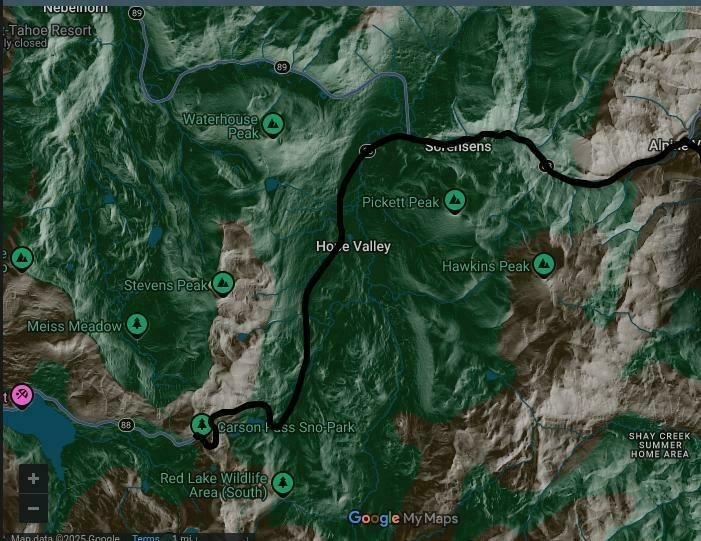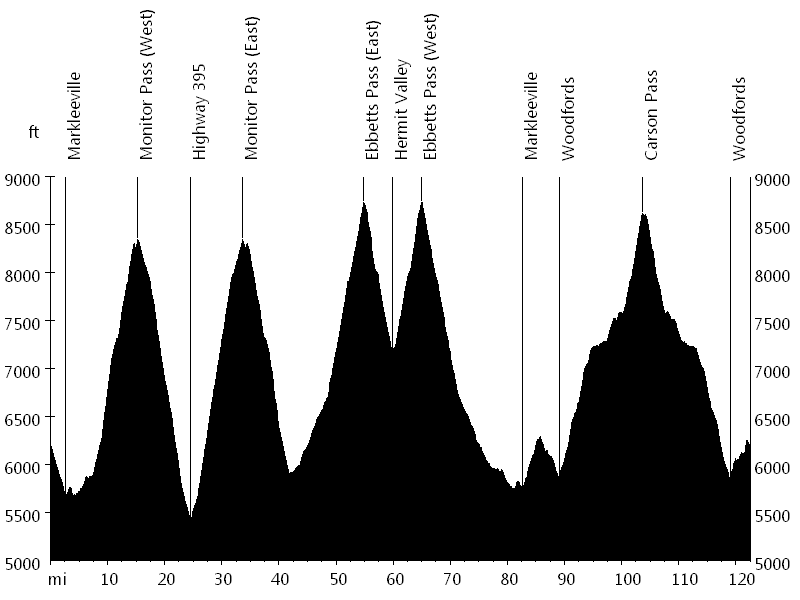While training for The Death Ride one year, so many years ago, I had quite a surprise on Highway 88 while descending Carson Pass in the Sierra Nevada. This was in the late season, the last week of October, a last minute plan with a best friend to get one last ride in before the snow storms arrived. On top of the usual physical challenges of climbing ~2,500' vertical up to 8,575 elevation, it was uncommonly cold.
For the background, I loved endurance racing, and the many long, standing (not seated) hill climbs and mountain passes always were my favorite. Climbing the front-side and then heading down the back-sides of big mountain passes in the Sierra Nevada at 50+mph (80kph) was however not my favorite - but a good lesson in reaping what you sow. Thankfully I never crashed on those, despite having climbed all of the majors and several lesser traveled, many times over: Monitor, Ebbetts, Carson, Echo, Rose, Yuba, Donner, Tioga, Brockway, Daggett, Luther, Pacific Grade Summit, and famously adjacent Geiger Grade going to Virginia City (a common morning ride before work). All of my crashes were on mountain and cyclo-cross, so I was certainly not immune.
The closest I came to a high speed get-off was on Carson Pass (highway 88), back in 2001. I was riding a new set of criterium race wheels that were ultra-lightweight, perfect for climbing up the pass to the summit, but during the descent speed-wobbles had set-in around the 45mph point and continued through to 54mph, starting directly after the first major right-hand curve.
While arc’ing the bike inside the turn, standard approach to manage centrifugal force, and then leaning it back upright as the road straightened, harmonic distortion set in, rippling faster and faster through the bike’s frame, up into my body, blurring my vision. Sometimes going faster will sort out the wave, but not this time, and by 50mph the flexing nearly tore the wheels apart from a combination of light-weight hubs and spokes/rims not having sufficient torsional strength to sustain the pressure involved with the induced coefficient-of-friction and centrifugal force.
This was the kind of turn with speed, which one can see racers engage with on the Tour, which require a rear-side body-torque movement to snap/push the frame out of its desire to continue through the curve and resume going straight - too much downward force started to turn the wheel into an slight oval. This same body movement is used in MotoGP and motocross racing, as it’s an essential skill for powering through a curve while pushing physical limits. The feeling was like that of an al-dente noodle, if one were to imagine being thrown down a hill while trying to keep everything straight and rigid - just stiff enough to not immediately die, but very close to dying really quickly. Wearing a helmet in that case wouldn’t have saved my life, as the pass is surrounded by granite walls and boulders and steep drops.
It took an entire mile of deceleration, achieved through pulsing the front and rear brakes at a 30/70% ratio (like anti-lock brakes on a car, but without the computer), to safely slow down enough for the distortion to resolve. If you don’t pulse the brakes then the pads can overheat and melt, contributing far worse conditions into the mix. By the ~30mph point I had recovered enough control over the bike to gently guide us to a turnout several miles down the pass and then dismount. A lot of adrenaline that day, the intensity of focus and attention to the senses required was certainly a high-point at my youngish age (early 20s).
My friend, a far better racer than I’d ever become, could only laugh at the scene. It wasn’t either of our first experiences with harmonic distortion, and what else is there to do but laugh and get back on the bike? Away we went, continuing down the steep but fast and straight-smooth road to Woodfords where we parked the car.
Well anyway, I had those wheels relaced with bladed titanium spokes and hardened steel nipples tensioned with a digital torque meter (not “feeling the torque by hand”), and never used them for hill climbs ever again.
As for The Death Ride, they no longer include Highway 88’s Carson Pass on the route, mostly due to safety.
References
- Beautiful photos and a grade map: www.tourofcalifornia.org/2006/07/d…
- Stats on the pass: en.wikipedia.org/wiki/Cars…
- The perfect yearly event: deathride.com
- Mentions about Carson no longer being used: deathride.com/faq/
#cycling #memories #theDeathRide #training #endurance


